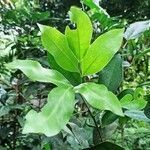| Therapeutic use
|
Diuretics (aerial part), Liver diseases (aerial part), Parasympatholytics (aerial part), Pharyngitis (aerial part), Anemia (bark), Gastrointestinal diseases (bark), Jaundice (bark), Liver diseases (bark), Snake bites (bark), Urologic diseases (bark), Gastrointestinal diseases (flower), Bronchitis (fruit), Cough (fruit), Dysentery (fruit), Hair loss (leaf), Anemia (leaf), Anthelmintics (leaf), Anticonvulsants (leaf), Antidotes (leaf), Antifungal agents (leaf), Antineoplastic agents (leaf), Antipyretics (leaf), Antirheumatic agents (leaf), Bites and stings (leaf), Chemoprevention (leaf), Cholestasis (leaf), Colic (leaf), Cough (leaf), Diabetes mellitus (leaf), Diarrhea (leaf), Dysentery (leaf), Eczema (leaf), Edema (leaf), Erysipelas (leaf), Female urogenital diseases (leaf), Fever (leaf), Flatulence (leaf), Gastrointestinal diseases (leaf), Gout (leaf), Headache (leaf), Helminthiasis (leaf), Hemorrhoids (leaf), Insect bites and stings (leaf), Insecticides (leaf), Intestinal diseases, parasitic (leaf), Jaundice (leaf), Liver diseases (leaf), Malaria (leaf), Pain (leaf), Skin diseases (leaf), Snake bites (leaf), Spasm (leaf), Vomiting (leaf), Wound healing (leaf), Wounds and injuries (leaf), Eczema (rhizome), Skin diseases (rhizome), Abdominal pain (root), Hair loss (root), Anemia (root), Anthelmintics (root), Anti-bacterial agents (root), Anticonvulsants (root), Anti-inflammatory agents (root), Antipyretics (root), Antirheumatic agents (root), Asthma (root), Breast neoplasms (root), Cardiovascular agents (root), Colic (root), Common cold (root), Cough (root), Diarrhea (root), Dysentery (root), Dyspepsia (root), Edema (root), Female urogenital diseases (root), Fever (root), Gastrointestinal diseases (root), Headache (root), Inflammation (root), Intestinal diseases, parasitic (root), Jaundice (root), Liver diseases (root), Malaria (root), Miliaria (root), Pain (root), Skin diseases (root), Snake bites (root), Stomach diseases (root), Vomiting (root), Insecticides (seed), Astringents (stem), Chest (unspecified), Dentifrice (unspecified), Eruption (unspecified), Fever (unspecified), Liver (unspecified), Skin (unspecified), Vermifuge (unspecified), Anemia (unspecified), Cough (unspecified), Eczema (unspecified), Jaundice (unspecified), Rheumatism (unspecified), Intestinal worms (unspecified), Abdominal pain (unspecified), Anthelmintics (unspecified), Anti-bacterial agents (unspecified), Anticonvulsants (unspecified), Antifungal agents (unspecified), Anti-inflammatory agents (unspecified), Antirheumatic agents (unspecified), Astringents (unspecified), Bronchitis (unspecified), Expectorants (unspecified), Helminthiasis (unspecified), Liver diseases (unspecified), Pharyngitis (unspecified), Skin diseases (unspecified), Liver neoplasms (unspecified), Anemia (whole plant), Antirheumatic agents (whole plant), Cough (whole plant), Jaundice (whole plant), Acne vulgaris (wood), Snake bites (wood)
|


